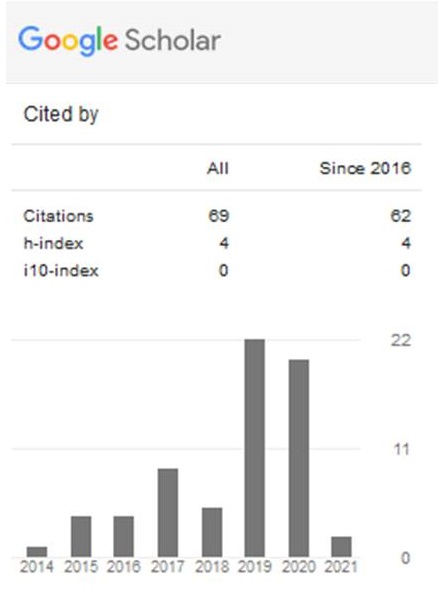Keanekaragaman Makrofauna Tanah pada Sistem Agroforestri Tanaman Kelapa Sawit dengan Pohon Gaharu
Abstract
Keywords
Full Text:
PDF (Bahasa Indonesia)References
Aini, F. K., Susilo, F. X., Yanuwiadi, B. dan Hairiah, K. 2006. Meningkatnya sebaran hama rayap odontotermes spp. setelah alih guna hutan menjadi agroforestri berbasis kopi: efek perubahan iklimmikro san ketersediaan makanan terhadap kerapatan populasi. J. Agrivita. 28 (3): 221-237.
Badan Pusat Statistik. 2019. Statistik Kelapa Sawit Indonesia 2018. Badan Pusat Statistik.
Bidura, G. 2017. Buku Ajar Agroforesti Kelestarian Lingkungan. Fakultas Peternakan, Universitas Udayana.
Dindal, D. L. 1990. Soil Biology Guide. A Wiley-Interscience Publication. United States of America.
Donovan, S. E., Egglenton, P. dan Bignell, D. E. 2001. Gut content analysis and a new feeding group classification of termit. J. Ecol Entomol 26 : 356-366.
Faoziah, N. 2016. Kelimpahan dan Keanekaragaman Fauna Tanah pada Perkebunan Kelapa Sawit dan Hutan Sekunder di Kabupaten Batanghari Provinsi Jambi. Skripsi. Institut Pertanian Bogor.
Ghazali, A., Asmah, S., Syafiq, M., M. S. Yahya, N. Aziz, T. Peng, A. R. Norhisham, C. L. Puan, Edgar C. T., Badrul, A. 2016. Effects of monoculture and polyculture farming in oil palm smallholdings on terrestrial arthropod diversity. Asia-Pacific Entomology. 19 : 415-421.
Habwandi, M. I. 2017. Komposisi Komunitas Makrofauna Tanah pada Hutan Sekunder dan Agroforestri Kopi di Desa Pangambaten Kecamatan Merek Kabupaten Karo. Skripsi. Universitas Sumatra Utara.
Husamah, R. A. dan Hudha, A. M. 2017. Ekologi Hewan Tanah (Teori dan Praktik), Universitas Muhammadiyah Malang Press. Malang.
Kartikasari H,. Heddy, Y. B. S. dan Wicaksono K. P. 2015. Analisis biodiversitas serangga di hutan kota malabar sebagai urban ecosystem services kota malang pada musim pancaroba. Produksi Tanaman. 3(8): 623-631.
Lisafitri, Y., Widyastuti, R. dan Santosa, D. A. 2015. Dinamika kelimpahan orribatida pada area perkebunan kelapa sawit di kecamatan bajubang batanghari jambi. Tanah Lingkungan. 17 (1): 33-38.
Murthy, I. K., Dutta, S., Varghese, V., Joshi P. P. dan Kumar, P. 2016. Impact of agroforestri systems on ecological and socio-economic systems: a review, Global journal of Science frontier research: H. Environment and Earth Science, 16:5.
Nandika, D., Rismayadi, Y. dan Diba, F. 2003. Rayap : Biologi dan Pengendaliannya. Surakarta. Muhammadiyah Universitas Press.
Nurrohman, E., Rahardjanto, A. dan Wahyu, S. 2015. Keanekaragaman makrofauna tanah di kawasan perkebunan coklat (Theobroma cacao L.) sebagai bioindikator kesuburan tanah dan sumber belajar biologi, Pendidikan Biologi Indonesia, 1 (2): 197-208.
Nusroh, Z. 2007. Studi Diversitas Makrofauna Tanah di Bawah Beberapa Tanaman Palawija yang Berbeda di Lahan Kering pada Saat Musim Penghujan. Skripsi. Universitas Sebelas Maret.
Pankhrust, C. E. 1994. Biological Indicators of Soil Health and Sustainable Productivity. In: Greendland DJ, Szabolcs I (Eds). Soil Resiliense and Sustainable Land Use. CAB International. Oxford.
Peritika, M. Z. 2010. Keanekaragaman Makrofauna Tanah pada Berbagai Pola Agroforestri Lahan Miring di Kabupaten Wonogiri Jawa Tengah. Skripsi. Universitas Sebelas Maret.
Rahmawaty. 2004. Studi keanekaragaman mesofauna tanah di kawasan hutan wisata alam sibolangit. J. Biology. 3 (1) :1 -17.
Ruiz, N., P. Lavelle dan Jimenez, J. 2008. Soil Macrofauna Field Manual, Food and Agricultur Organization of The United Nations, Rome.
Simarmata, T. 2012. Ekologi Biota Tanah. Prisma Press. Bandung.
Suhardjono Y. R. 2012. Serangga serasah: keanekaragaman takson dan perannya di kebun raya bogor. Biota. 3: 16-24.
Suhartati dan Wahyudi, A. 2011. Pola agroforestri tanaman penghasil gaharu dan kelapa sawit (agroforestri pattern of agarwood species and oil palm). J. Pend. Hutan dan Konservasi Air. 8 (4): 363 - 371.
Suin, N. M. 2003. Ekologi Hewan Tanah. Bumi Aksara. Jakarta.
Semiun, C. G., Stanis S. 2016. Kelimpahan dan keanekaragaman arthropoda tanah pada lahan pertanian monokultur dan polikultur di desa labat kupang. Bio Wallacea, 2 (3): 154-161.
Tangjang S dan Arunachalam, K. 2009. Microbial population dynamics of soil under traditional agroforestri systems in northeast india, Research Journal of Soil Biology, 1(1) : 1-7.
Thamrin, M., Rauf, A. dan Hidayat, B. 2017. Dampak penanaman pohon hutan di lahan perkebunan karet (havea brasiliensis muell. arg) pada sifat biologi di kecamatan bahorok kabupaten langkat. Jurnal Agroteknologi FP USU. 5 (2): 362-272.
Triplehorn., C.A. dan Johnson, N. F. 2005. Borror and delong’s introduction to the study of insects seventh edition. Brook/Cole. United States of America.
Zulkaidhah, Hapid, A. dan Ariyanti. 2017. Keragaman jenis rayap pada kebun monokultur kakao di hutan pendidikan universitas tadulako sulawesi tengah, Forest Sains, 14 (2) : 80-84.
Refbacks
- There are currently no refbacks.

_2017.jpg)



